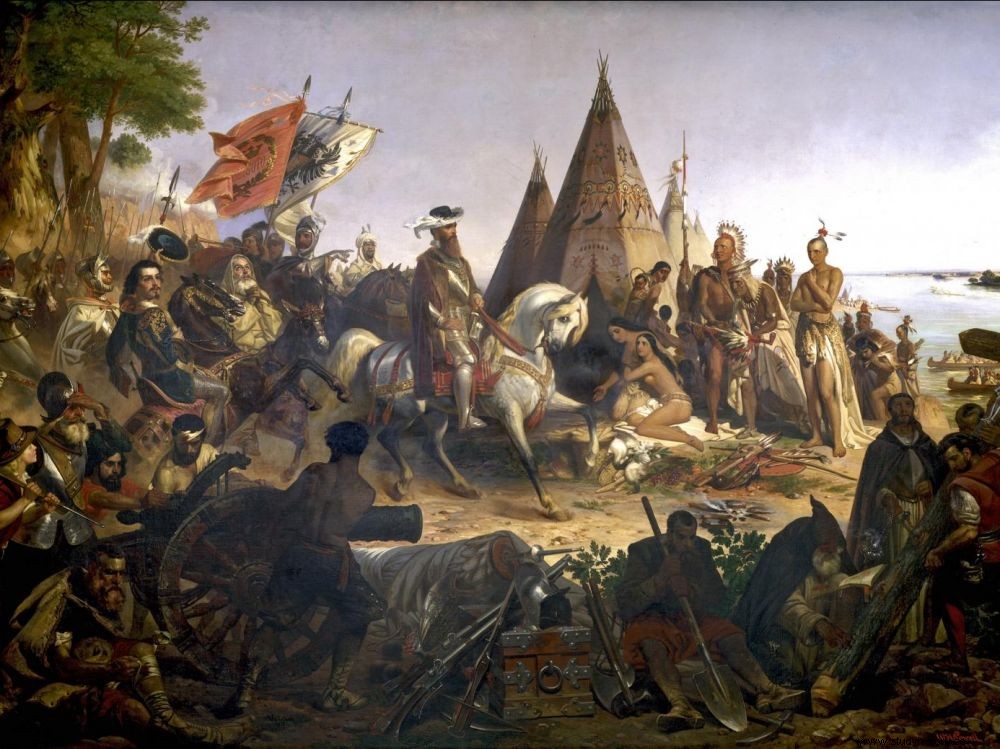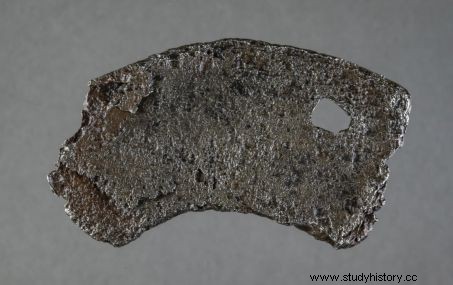A team of American archaeologists unearthed more than 80 metal objects of European origin in Mississippi. They estimate that they belonged to Hernando de Soto's expedition, made up of more than 600 men, horses and pigs before the Chickasaws (Chickasaws) integrated them into their daily lives by giving them new uses.

Painting painted by William Henry Powell in 1855, illustrating the discovery of the Mississippi by the troops of Hernando de Soto in 1541 and the encounter with Native American peoples.
In 1539, Hernando de Soto (1500–1542), a prominent figure in the conquest of the Inca Empire, then recently governor of Cuba, began his attempt to conquer North America. While the expedition is documented in the accounts published by some of its members upon their return, the exact route taken by de Soto and his men is debated by historians, who until now could only rely on evidence. very sparse archaeological finds to fill the gaps in written information.
The Chickasaws, an indigenous people originally from the northeastern region of Mississippi and moved to Oklahoma by the US government in 1837, hired a team of archaeologists in 2015 in the hope of discovering that beneath their homeland lay clues to their past. It was not a question of looking for objects of European origin, on the contrary. However, thanks to the metal detector, archaeologists have found more than 80, as they explain in an article published by Cambridge University Press.
The Chickasaws appropriated the objects left by the Spaniards
Excavations have confirmed that the troops led by Hernando de Soto encountered the Chickasaws while they were occupying part of the territory of present-day Mississippi.
In 1539, Hernando de Soto (1500–1542), a prominent figure in the conquest of the Inca Empire, then recently governor of Cuba, began his attempt to conquer North America. While the expedition is documented in the accounts published by some of its members upon their return, the exact route taken by de Soto and his men is debated by historians, who until now could only rely on evidence. very sparse archaeological finds to fill the gaps in written information.
The Chickasaws, an indigenous people originally from the northeastern region of Mississippi and moved to Oklahoma by the US government in 1837, hired a team of archaeologists in 2015 in the hope of discovering that beneath their homeland lay clues to their past. It was not a question of looking for objects of European origin, on the contrary. However, thanks to the metal detector, archaeologists have found more than 80, as they explain in an article published by Cambridge University Press.
The Chickasaws appropriated the objects left by the Spaniards
Excavations have confirmed that the troops led by Hernando de Soto encountered the Chickasaws while they were occupying part of the territory of present-day Mississippi. The Spanish colonists are said to have first maintained good relations with them, with whom they spent the winter, between December 1540 and March 1541, before the situation deteriorated, the two groups clashed and the expedition Spanish decides to flee to the North, leaving behind some of their possessions.
What is interesting, for Charles Cobb, lead author of the study, is that suddenly, rare and expensive European objects, reserved for the European elite or for strategic exchanges, fell, in abundance, into the hands of these Native Americans. The archaeologist explains in an interview with the Museum of Florida that a moment of appropriation followed, during which the Chickasaws discovered the tools and materials used by Europeans and were inspired by them.
The Chickasaws then used bones, stones, sticks as materials to shape their tools:the collection of metal objects therefore allowed them to perfect them. This is how the team of archaeologists found iron replicas of traditional Native American axes. But the objects collected by Native Americans sometimes seem to have been recut in order to divert them from their original use. The Chickasahs would have transformed horseshoes into knives or pieces of copper into jewelry.

Piece of horseshoe used by Chickasaws as a cutting object. Credits:Jeff Gage/Florida Museum of Natural History
A cultural transfer with dark foundations
In their publication, the archaeologists question the nature of the phenomenon reflected in the evidence of the reappropriation of European objects by the Chickasaws in the middle of the 16th century. Hybridization is a fairly logical social mechanism, in a situation where two societies, two civilizations, meet. But the particularity of the colonial context being the imposition of one culture on another, hybridization is often suffered. For Charles Cobb, however, the Chickasaws voluntarily incorporated the colonists' culture into a dialogue with their own, since the Spaniards were not yet in a strong position in the mid-16th century. They were, in fact, forced to flee following the attack of the Amerindians, and, in 1541, the colonial institutions still emerge on the Mexican territory, conquered twenty years earlier.
Archaeologists have nevertheless found long chains, testifying to the ambition of the Spaniards to set up forced labor of the Amerindians. The attack by the Chickasaws was already known to have come after the Spanish colonists demanded 200 of their men to carry their equipment to their next encampment, but this chilling discovery is reminiscent of the brutality of the Spanish conquests. For Charles Cobb, Hernando de Soto's expedition could thus constitute one of the first episodes in the introduction of slavery on the American continent.
Finally, after more than a century of isolation, the new contacts with Europeans at the beginning of the 18th century would give rise to another type of cultural and technological exchange. The objects will then be more faithfully incorporated into the Chicachas' daily lives. For Charles Cobb, “in the 16th century, a thimble could be transformed into a bracelet. At the end of the 18th century, a thimble was a thimble ”.
